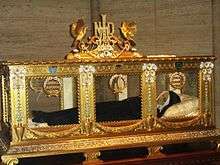Sisters of Charity of Nevers
|
The motherhouse at Nevers | |
| Founder | |
|---|---|
| Jean-Baptiste Delaveyne, 1680 | |
| Religions | |
| Roman Catholicism |
The Sisters of Charity of Nevers (French: Congrégation des Sœurs de la Charité de Nevers), also known as Sisters of Charity and Christian Instruction, is a religious institute founded in 1680 in Nevers, Nièvre department, France, at the instigation of Jean-Baptiste Delaveyne. The motherhouse, the convent at St. Gildard in Nevers, is built on the ruins of the priory of Saint-Gildard,[1] and was supervised by the bishop of the diocese of Nevers.[1]
History
In 1678, Jean-Baptiste Delaveyne (1653–1719), a Benedictine who had spent seven years being dazzled by the court of Louis XIV of France, returned to Saint-Saulge, the hamlet in the Nièvre department where he was born, in an attempt to regain the spiritual direction of his youth. Struck by the poverty he found in that rural area, he offered the young ladies of the village of Saint-Saulge a challenge: "Have no other business but that of charity. Have no other interests but those of the unfortunate." This challenge led to the congregation's foundation.[2] Delaveyne organized a small house with Sisters who ministered to the sick and the poor.[3]
The congregation was housed in Château-Chinon in 1706. In 1710 they moved to Decize to serve in the local hospital, and in 1716 they consecrated a chapel in Saint-Saulge to the Immaculate Conception. In 1748 they returned to Château-Chinon, to its hospital.[4] While the Sisters initially ministered to the poor, during the nineteenth century they were more oriented toward the middle classes (and most of the novices were middle-class girls), and by the 1860s operated 260 convents in France.[3]
In 1853, the Sisters were given the former Church of Saint Lupus and Saint Gildard in Nevers by Dominique-Augustin Dufêtre, bishop of Nevers, to build a religious house; it was officially consecrated on 15 July 1856.[5]
Notable sisters

The religious institute is best known for having had Bernadette Soubirous, also known as Saint Bernadette of Lourdes, as a member in the motherhouse at Nevers;[6] after having received her visions, Bernadette entered the school in Lourdes run by the sisters,[7] who had opened a hospice in Lourdes in 1834.[8] In 1866, she was accepted to take her novitiate in Nevers, where she died in 1879. Her body is enshrined in the St. Gildard Convent's chapel in Nevers.[7] Today, the Sisters also tend the cachot, the basement apartment in Lourdes where Soubirous lived during her youth;[9] in 2008, the Sisters received Pope Benedict XVI in the cachot, before he visited the grotto in Lourdes.[10]
Another notable Sister was Marcelline Pauper, born 1663, who entered at Nevers at age twenty-two.[11] Her autobiography was published in 1871;[12] in it, she described how she made reparations for a sacrilege that had occurred in the chapel by receiving the stigmata, on 26 April 1702.[11][13]
Establishments
A daughter organization of the Daughters of Charity of Saint Vincent de Paul, the Sisters of Charity of Nevers operate hospitals[14] and had convents and schools throughout France. The Sisters are active in Asia, Africa, and South America.[15] It also operates:
- Sainte-Anne, a retirement home in Luc-la-Primaube, Aveyron, France[16]
- Retirement home and home for handicapped children (Auxerre), homeless shelter (Sens), in the Roman Catholic Archdiocese of Sens, Yonne, France[17]
References
- 1 2 Marbot, Edmond (1889). La sainte église d'Aix et Arles: Nos évêques. A. Makaire. pp. 327–41.
- ↑ "L'aventure d'un homme : Jean-Baptiste Delaveyne (1653-1719)". www.sainte-bernadette-nevers.com. Retrieved 29 December 2010.
N'ayez point d'autres affaires que celles de la Charité. N'ayez point d'autres intérêts que ceux des malheureux.
- 1 2 Taylor, Thérèse (2003). Bernadette of Lourdes. Burns and Oates. p. 204. ISBN 0-86012-337-5.
- ↑ Bulletin de la Société nivernaise des lettres, sciences et arts, Volume 7. Société Nivernaise des Lettres. 1872. p. 226.
- ↑ Crosnier, Augustin-Joseph (1858). Hagiologie nivernaise: ou, Vies des saints et autres pieux personnages qui ont édifié le diocese de Nevers par leurs vertus. I.-M. Fay. pp. 352–61.
- ↑ Taylor, Thérèse (2003). Bernadette of Lourdes. Burns and Oates. pp. 203–74. ISBN 0-86012-337-5.
- 1 2 Merriam-Webster's encyclopedia of world religions. Merriam-Webster. 1999. p. 124. ISBN 978-0-87779-044-0.
- ↑ "Pèlerin à Lourdes, Benoît XIV achève son 'Chemin du Jubilé'". Zenit. Retrieved 29 December 2010.
- ↑ El-Fers, Mohammed (2009). The Complete Guide to Lourdes. Mohammed El-Fers. p. 34. ISBN 978-1-4092-9296-8.
- ↑ "Benoît XVI sur le chemin du Jubilé à Lourdes". La Dépêche du Midi. 13 September 2008.
- 1 2 Imbert-Gourbeyre, Antoine; Joachim Bouflet (1996). La stigmatisation: 1894. Editions Jérôme Millon. pp. 365–67. ISBN 978-2-84137-035-1. Retrieved 29 December 2010.
- ↑ DeJean, Joan (1991). Tender geographies: women and the origins of the novel in France. Columbia UP. p. 215. ISBN 978-0-231-06230-5.
- ↑ Summers, Montague (1926). History of Witchcraft and Demonology. pp. 145–46. Retrieved 29 December 2010.
- ↑ Lindemann, Mary (2010). Medicine and Society in Early Modern Europe. Cambridge UP. p. 163. ISBN 978-0-521-73256-7.
- ↑ "Les Soeurs de la Charité de Nevers". www.sainte-bernadette-nevers.com. Retrieved 28 December 2010.
- ↑ Bessou, Marie-Christine (5 December 2010). "Cinq centenaires à La Primaube". La Dépêche du Midi. Retrieved 29 December 2010.
- ↑ "Les Sœurs de la Charité de Nevers". Roman Catholic Archdiocese of Sens. Retrieved 30 December 2010.
External links
- Charité de Nevers on CORREF
